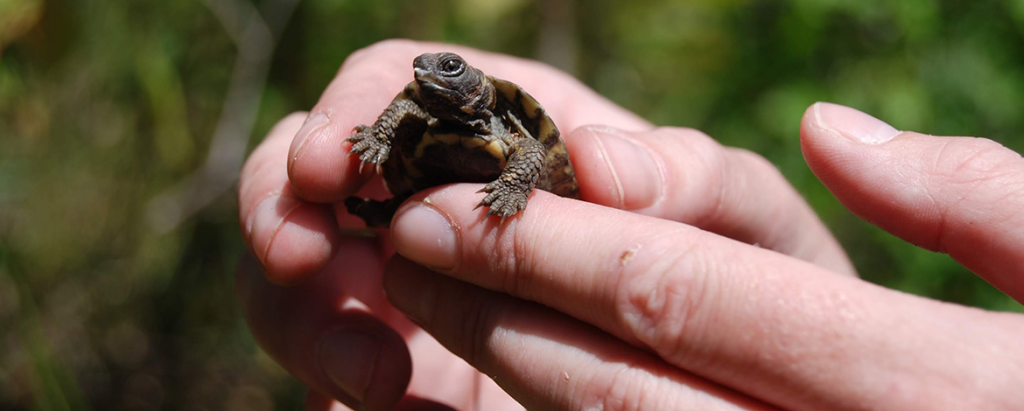Your donation benefits wildlife and natural areas
Your generous contribution to the Endangered Resources Fund will support the following conservation work by DNR Natural Heritage Conservation staff.
Online donors: You may direct your gift to one of the specific areas listed below. Please indicate your preference in the "Donation Details" drop-down menu on the online donation page.
Bats
- Continue working with partners of DNR’s Wisconsin Bat Program [exit DNR] to test treatments to save bats.
- Conduct, train and equip volunteers to survey streams, rivers and lakes statewide to help determine the distribution and range of Wisconsin’s bat species and to assess white-nose syndrome impacts on them.
- Continue research to identify bats' summer habitats to better protect them.
- Monitor and conduct more research to study Wisconsin's newly discovered bat species, the evening bat.
Plants and natural communities
- Provide accurate and up-to-date information on rare species to land managers through the Natural Heritage Inventory Portal.
- Coordinate volunteer participation in the Rare Plant Monitoring Program [exit DNR].
- Collaborate with regional partner groups to provide resources and assistance that help them work on invasive species outreach, prevention and control of emerging infestations at the local level.
- Manage habitat and conduct research and surveys on Wisconsin’s six federally threatened plants: Fassett’s locoweed, northern wild monkshood, prairie bush clover, prairie white-fringed orchid, Pitcher’s thistle and dwarf lake iris.
- Conduct surveys and monitor natural communities to enhance our knowledge of Wisconsin’s native ecosystems and to discern important changes over time.
- Provide training, publications and online resources for landowners and land managers.
- Conduct biotic inventories and identify Primary Sites as part of the process for Master Planning at state properties.
- Assess how native plants and natural communities may respond to changing environmental conditions (e.g., flood, drought), and promote management on public and private lands that takes such changes and responses into account.
Reptiles and amphibians
- Locate and map Wisconsin’s native amphibian and reptile populations, including those that are rare or declining.
- Coordinate statewide citizen-based inventory and monitoring projects like the Wisconsin Frog and Toad Survey [exit DNR] and the Wisconsin Turtle Conservation Program.
- Conduct research regarding the status and health of native amphibians and reptiles and their habitats, including mink frogs, ornate box turtles, wood turtles and ribbonsnakes.
- Provide outreach and education about the importance of native amphibians and reptiles and the places they call home.
- Conduct surveys for the state endangered eastern massasauga rattlesnake. Due to dramatic declines throughout its global range, the massasauga is now also listed as federally threatened.
Insects and aquatic species
- Conduct surveys for Endangered/Threatened mussels including snuffbox, salamander, sheepnose, spectaclecase, fawnsfoot, rock pocketbook, slippershell, rainbow and ellipse mussels.
- Monitor populations of the state and federally endangered Higgin's eye pearlymussel and winged mapleleaf mussel.
- Support statewide citizen-based monitoring of dragonflies, damselflies, freshwater mussels, Karner blue butterflies and bumble bees through the Mussel Monitoring Program of Wisconsin, the Wisconsin Odonata Survey , Karner Volunteer Monitoring Program, and the Wisconsin Bumble Bee Brigade .
- Manage habitat and conduct research and surveys on Endangered/Threatened/Species of Concern including northern blue butterfly, Karner blue butterfly, Poweshiek skipperling, regal fritillary, Ottoe skipper, monarch butterfly, rusty patched bumble bee, Phlox moth, red-tailed leafhopper, hairy-necked tiger beetle and Hine's emerald dragonfly.
- Support statewide efforts to increase habitat for the monarch butterfly through the Wisconsin Monarch Collaborative .
Birds
- Analyze, summarize and map results from the Wisconsin Breeding Bird Atlas II, a five-year project to document the distribution and abundance of Wisconsin’s breeding bird species. The project will provide the most current information on rare bird species throughout the state.
- Protect state endangered bird populations, including those of the peregrine falcon, piping plover and Kirtland's warbler.
- Manage and conserve habitats used by breeding and migrating birds
- Search for bald eagle nests around the state. Nest locations are provided to our partners and utility companies for research, monitoring and planning purposes.
- Monitor and manage Wisconsin's tern populations, including the state endangered black, Caspian, common and Forster’s terns.
- Reintroduce a migratory population of whooping cranes to eastern North America.
- Monitor secretive bird species through citizen-based surveys for owls, nightjars and marsh birds.
State natural areas
- Manage Wisconsin's native landscapes by eradicating invasive species and conducting prescribed burns to maintain their biological diversity.
- Preserve State Natural Areas for scientific research, nature-based recreation and environmental education.
- Provide outreach and education about the importance of the ecological communities and the endangered plants and animals protected in Wisconsin’s State Natural Areas.
Mammals
- Perform small mammal surveys, targeting Species of Greatest Conservation Need, at various state-owned properties to inform small mammal distribution, status and abundance throughout the state.
- Evaluate abundance, distribution and demography of American marten populations in northern Wisconsin using three non-invasive survey methods: snow tracking, field cameras and genetic sampling from hair snares.

